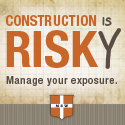| |
Contact Us Archives
Subscribe Printer-Friendly AdvertiseSafety and HealthConstructor Buyers' Guide Facebook 

Top News
Regulatory & Legislative Updates
Events
Chapter News
Best Practices
Safety Cabinet
|
|

The Occupational Safety and Health
Administration invites interested parties to attend a day-long roundtable
discussion on the agency’s draft updated Safety and Health Program Management Guidelines.
The meeting is set for Thursday, March 10, 2016, from 9 a.m. to 5 p.m. at the
U.S. Department of Labor’s Frances Perkins Building in Washington, D.C.
Those wishing to attend must register here by March 3. Attendees can
choose from several levels of participation in the discussion, which will cover
the guidelines in general plus key issues that were raised in public comments.
The comment period closes Feb. 22, 2016.
First published in 1989 to help employers establish their own
safety and health programs, the guidelines are being updated to reflect changes
in the workplace and modern safety practices. They should be particularly
helpful to small- and medium-sized businesses, and also provide approaches that
multiple employers at the same worksite can use to coordinate their efforts to
protect all workers.
Under the Occupational Safety and Health Act of 1970, employers
are responsible for providing safe and healthful workplaces for their
employees. OSHA’s role is to ensure these conditions for America’s working
men and women by setting and enforcing standards, and providing training,
education and assistance. For more information, visit www.osha.gov.
Source: OSHA
|

97th Annual AGC Convention
March 9-11, 2016
San Antonio, Texas
 Grab your hats, don your boots, and join your fellow construction industry professionals at the 97th Annual AGC Convention, March 9-11, 2016, at the Grand Hyatt San Antonio. As our premier event each year, the AGC Annual Convention and Technology & Construction Solutions Expo is the ideal opportunity to see everything AGC can do for you and your business. Join us for more than 15 education breakouts, terrific networking events and industry leading speakers, all in a perfect location for business, culture, family and fun ... San Antonio.
Learn more.
|
AGC Safety Management Training Course
March 14-16, 2016
O'Fallon, Illinois
The AGC Safety Management Training Course (SMTC) provides attendees three days of training on the basic skills needed to manage a company safety program in the construction industry. The program builds on Focus Four training and prepares attendees to manage key safety issues on the job site and provides techniques for delivering basic safety training to field personnel. Participants will receive intensive instruction and training that will allow them to return to their firms with readily applicable new skills to positively impact their company’s safety and health program.
|
Third Annual National Safety Stand Down
May 2-6, 2016
OSHA, the National Institute for Occupational Safety and Health, and the Center for Construction Research and Training will hold the third annual National Safety Stand-Down May 2-6, 2016, to raise awareness of the serious risk of falls in the workplace. Falls are the leading cause of death in the construction industry, and lack of proper fall protection remains the most frequently cited violation by OSHA. More than 4 million workers have participated in the last two years, dedicating themselves to on-the-job safety. This year the stand-down will highlight the safe use of ladders and encourage employers to pause during their workday for topic talks, demonstrations and training on how to prevent falls. For more information on the success of last year's stand-down, see the final data report. Visit the 2016 National Safety Stand-Down webpage for more updates.
|
BY F. MARIE ATHEY
Sparks fly, combustibles
go boom, and workers flee the scene with smoldering clothing or materials. This
sounds like the perfect script for a Halloween movie. Only it is all too real
of a possibility when you are working on construction sites with dangerous
chemicals, faulty wiring or haphazard fire safety training. No wants to be
caught on fire when trying to earn a living at a construction site. Here are five ways to prevent fires at work:
HAVE FIREFIGHTING EQUIPMENT AVAILABLE
The National Institute
for Occupational Safety and Health (NIOSH), through theCDC,has compiled a list of fire prevention
measures for construction work. One of the first requirements is to have
firefighting gear on hand. You should have firefighting equipment (i.e., fire
extinguishers and water drums, less than 100 feet away from the jobsite). These
items should be easily identifiable and regularly checked for damage or water
loss. These items will help you to prevent sparks from spreading into fire
walls.
KEEP IT CLEAN
The
last thing contractors want to do when working on a construction site is to clean up
the place. However, layers of
combustible dust, mountains of dry wood, and cans of half-used paint are ideal
snacks for a greedy fire. Sweep up, straighten up, and don’t stop there. Keep
the weeds and grass at bay, so they don’t help any fire to spread around the
site.
HEATING UP
As the warm weather
flees the scene, you can bet that your workers will want to have a heater or
two on the worksite. Herein lies the hazard. Heating devices might keep your
workers from getting frosty, but they are also a great danger in terms of fire
safety. Choose devices that are made for construction sites, which include
non-toppling units with safety shields, to protect workers from brushing up and
burning their clothing.
SAY "NO" TO FIRES
Never have an open
fire on a worksite. Make the worksite a no smoking zone—free of matches and
lighters. By not bringing open flames into your workplace, you are helping to
enhance the fire prevention abilities of your workers. This also means no
burning of construction materials, trash or other items on the worksite. Most
cities and states have fire ordinances that prevent this as well, so make sure
not to break the law.
ZAP OUT ELECTRICAL HAZARDS
Electrically grounded
fire hazards cannot be taken lightly. Sparks can fly, with electricity zipping
through the bodies of your workers in seconds, and may lead to explosions that
catch everything on fire. Don’t wait for the worst to happen—arm your crew with
knowledge through NFPA 70E training. Define and highlight the Electrical Safety
Standard with some professional training.\
Source: http://www.cdc.gov/HomeandRecreationalSafety/Fire-Prevention/.
F. Marie Athey has been with OSHAcampus.com since 2012 as the company's occupational health and safety technologist. She earned her degree in Environmental Health and Safety Technology from the Texas State Technical College. Marie has more than 15 years of industry experience in occupational health and safety having worked for various U.S. companies in construction and general practice.
|
|
|

 2300 Wilson Boulevard, Suite 300 · Arlington, VA 22201 · 703-548-3118 (phone) · 703-548-3119 (fax) · www.agc.org
2300 Wilson Boulevard, Suite 300 · Arlington, VA 22201 · 703-548-3118 (phone) · 703-548-3119 (fax) · www.agc.org
 AGC Encourages Members to Participate in OSHA’S Public Stakeholder Meeting on its Draft Updated Safety and Health Program Management Guidelines
AGC Encourages Members to Participate in OSHA’S Public Stakeholder Meeting on its Draft Updated Safety and Health Program Management Guidelines



 Grab your hats, don your boots, and join your fellow construction industry professionals at the
Grab your hats, don your boots, and join your fellow construction industry professionals at the 